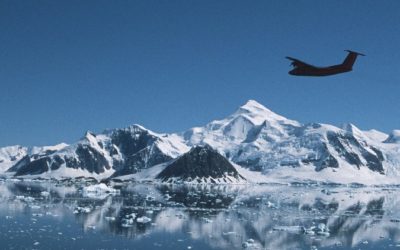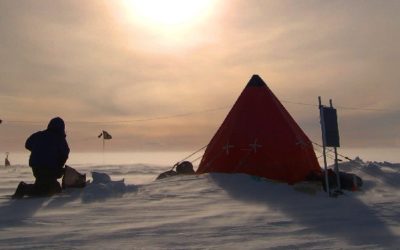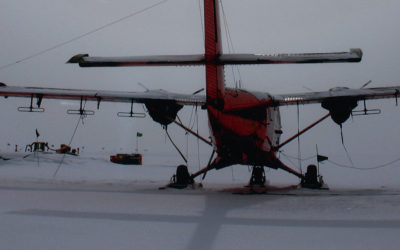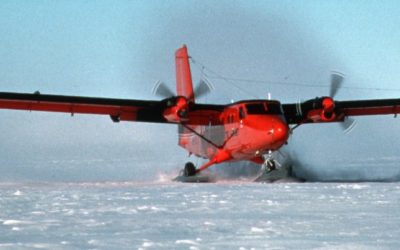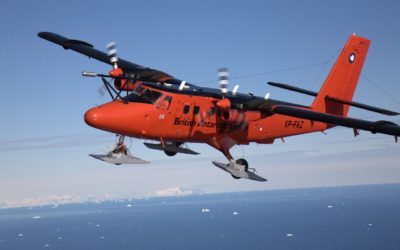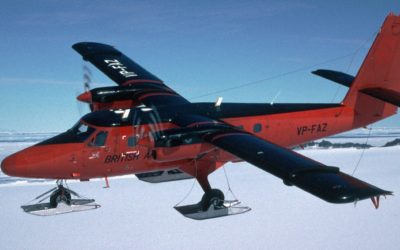
Aerogravity system
BAS has developed aerogravity systems that can be mounted in its geophysical survey aircraft, or in a UAV. Over 100,000 km of gravity data has been collected since such systems …
The British Antarctic Survey has many decades of experience collecting processing and distributing a wide range of aerogeophysical data from across Antarctica. It operates a Twin Otter aircraft with a certified fit of airborne geophysics instrumentation that support our programme of sustained observations. In addition we are developing our capability to deploy geophysical and other remote sensing instruments from Uncrewed Aerial Vehicles (UAVs).
The core geophysical instrument suite includes gravimeter, magnetometers and polametric ice-penetrating radar (PASIN-2). This suite can be flown with LIDAR, camera, hyperspectral or other radar systems in support. The instrument suite has been widely employed on NERC and other grants.
Twin Otter survey aircraft
The primary geophysical survey platform is a Twin Otter aircraft. This very adaptable and robust platform is used the world over as a ‘bush’ aircraft. Its twin turbo-prop engines and ‘Short Take off and Landing’ (STOL) capability allow it to be operated from small, remote unpaved airfields. The addition of skis or tundra tyres also allows operation on snow from remote camps. The aircraft can be operated single pilot and a long range fuel tank is also available. In general the aircraft works in the Antarctic from October through to March each year. Outside the Antarctic season the aircraft is available in the Northern hemisphere.
Installations are flexible allowing for tailored missions for gravity, radar, magnetics or hyperspectral data collection or any combinations of the systems. Hard points in the wings allow for mounting of 8 radar antennas, while a belly antenna housing can add an additional four receive elements to the PASIN radar antenna array, or support other radar systems. Pods can be fitted at the wing tips for the magnetometer installation.
The camera bay, beneath a central floor hatch, can accommodate a scanning laser used for measuring ice surface elevation. A digital SLR camera can also be fitted to provide visual references for the data sets. A hyperspectral suite of imaging equipment can be utilised in the camera bay for a wide range of survey applications such as geology or vegetation studies. Alternatively a higher frequency accumulation radar can be fitted within the camera bay, giving higher resolution images of the internal structure of the ice sheet, but with shallower penetration of the ice. The required GPS and attitude measurements to support survey operations are fed data from up to three antennas mounted on the roof of the aircraft, with data typically logged to a Javad GNSS receiver.

UAV survey platform
Large UAVs, such as the Windracers Ultra, can carry many of the geophysical and other Earth observation instruments noted above. In some cases such platforms have distinct advantages over traditional aircraft, for example for smaller survey areas, where slow flight is required, or where fuel is at an extreme premium. Supported by Innovate UK BAS have successfully deployed magnetic, gravity, hyperspectral and visual camera systems from the Windracers Ultra platform in Antarctica on survey missions up to 260 km long and will continue to develop this capability. For UAV operations science equipment is pre-installed on a bespoke ‘floor’ which simply slots into the UAV payload bay. Science equipment either collects data across the entire duration of the mission, or is switched on/off automatically when specific mission waypoints are achieved. Due to weight restrictions the UAV surveys are currently limited to a sub-set of the instruments at any specific time, but future advances will reduce this limitation.
View the BAS Polar Airborne Geophysics Data Portal to access datasets and metadata. Individual datasets can also be accessed from the Project pages.

BAS has developed aerogravity systems that can be mounted in its geophysical survey aircraft, or in a UAV. Over 100,000 km of gravity data has been collected since such systems …
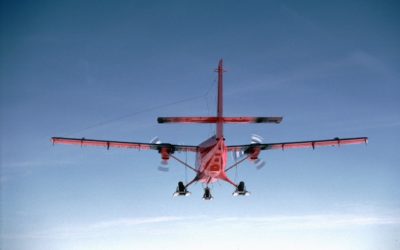
The radar system is composed of a complex waveform generator, signal processor, data handler and data store. It includes a high power transmitter (up to 66dBm or 4kW), a low …
26 January, 2016 by Tom Jordan
Wrapping up I have started several of my blog posts saying I am writing in various odd/unusual/uncomfortable locations…the back of a Twin Otter, or in a mountain tent high on …
18 January, 2016 by Tom Jordan
Culture shock Just over two weeks ago I was writing this blog hunched up in a mountain tent, having not washed for a week, and with the company of just …
6 January, 2016 by Tom Jordan
The altimeter in the front of the Twin Otter aircraft is showing 8500 ft as we cruise due south from Rothera research station for the next leg in our PolarGAP …
2 December, 2015 by Ashly Fusiarski
As we finally approached our input site I could see our future home in the distance, a little black dot on a frozen white ocean, slowly growing in size as …
31 May, 2023
The ground beneath Antarctica’s most vulnerable glacier has been mapped for the first time, helping scientists to better understand how it is being affected by climate change. Analysis of the …
1 August, 2018
A new ‘heat map’ shows, in unprecedented detail, how geothermal heat is escaping through the Earth’s surface beneath the Greenland Ice Sheet. This is critical information for enabling scientists to …
24 May, 2018
Revealing Antarctica’s hidden world
23 January, 2016
Scientists now have a new tool to investigate the deep structure of the least understood continent on Earth
23 November, 2015
New season tackles ambitious science and logistical challenges The British Antarctic Survey (BAS) 2015/16 field season is underway with dozens of scientists and support staff – together with planes and tonnes …
19 November, 2014
Antarctic “ghost mountains” preserved by ice sheet A new study reveals how the rugged ridgelines of East Antarctica’s ancient and mysterious ‘ghost mountains’ have been preserved for millions of years …
27 January, 2014
In this month’s International Innovation journal Dr Fausto Ferraccioli discusses how airborne geophysics can be used to uncover the geology of Antarctica and explore some of the Earth’s final frontiers. …
16 November, 2011
Gamburtsev Mountains enigma unraveled in interior East Antarctica The birth of the Gamburtsev Subglacial Mountains buried beneath the vast East Antarctic Ice Sheet — a puzzle mystifying scientists since their …
3 March, 2011
Ice structures found among hidden Antarctic mountains The discovery of numerous large ice structures within Antarctica’s Dome A region, the site of the buried ‘ghost mountains’, reveals new understanding about …
13 October, 2008
Challenge to discover Antarctica”s hidden world Later this month teams of scientists, engineers, pilots and support staff from British Antarctic Survey (BAS), USA, Germany, Australia, China and Japan will join …
West Antarctic ‘rivers’ of ice
Exploring Antarctica's 'ghost mountains'
The BBAS science programme was a British Antarctic Survey-funded project, part of the wider BBAS-AGASEA collaboration between BAS, the University of Texas Institute for Geophysics (UTIG), and the U.S. National …
Bedmap is a collaborative community project with the aim to produce a new map and datasets of Antarctic ice thickness and bed topography for the international glaciology and geophysical community, …
Bedmap3 is a collaborative community project with the aim to produce a new map and datasets of Antarctic ice thickness and bed topography for the international glaciology and geophysical community, …
Understanding the contribution that polar ice sheets make to global sea-level rise is recognised internationally as urgent. The mission of this five-year project is to capture new observations and data …
The GRADES-IMAGE science programme was a British Antarctic Survey-funded project over the Antarctic Peninsula and Filchner-Ronne Ice Shelf. The aim of the programme was to image englacial layering and bedrock …
The ICEGRAV project is a major international collaboration between Danish, US, UK, Norwegian and Argentinian scientists. The primary aim of the project is to carry our airborne gravity observations across …
The NERC Airborne Geophysics Data Portal provides direct access to airborne survey data.
The polar regions have the capacity to amaze and astound, but despite the considerable progress of recent decades we still know far less about them than less remote parts of …
PRESCIENT (UK Polar Research Expertise for Science and Society) is a joint programme between BAS (British Antarctic Survey) and CPOM (the Centre for Polar Observation and Modelling). The programme supports …
The WISE-ISODYN (WISE: WIlkes Basin/Transantarctic Mountains System Exploration; ISODYN: Icehouse Earth: Stability Or DYNamism?) science programme was joint UK-Italian project between the British Antarctic Survey and the Italian Programma Nazionale …
Using this facility:
Access to this facility is through funded collaborative research grants.
For more information, or to discuss any potential proposals, or use of equipment please contact the Head of Airborne Geophysics (Tom Jordan; tomj@bas.ac.uk) or Head of Airborne Survey Technology (Carl Robinson; carob@bas.ac.uk).
Please contact us at least 3-months before the call deadline to ensure that proposals can be fully costed and accommodated. To ensure successful delivery of projects a component of BAS science and engineering staff time will likely need to be included in the project proposal. However, use of BAS Antarctic logistics, including BAS aircraft and fuel within the traditional BAS operational area, comes as “free at point of use” to projects funded by UKRI.
In addition for any field operations there will be a requirement to complete a Pre Award Operational Support Planning Questionnaire (OSPQ) to asses the feasibility of the project from a logistical perspective (three months before the call deadline).
| Range: | 1000km including skis. Increased with long range tank depending on configuration. |
|---|---|
| Airspeed: | Cruise 65m/s. Data collection 60m/s. |
| Complement: | Pilot + maximum 4 mission operators / scientists. |
| Altitudes: | <35m to 5000m. Unpressurized but with oxygen fit for pilots and operators. |
| Range: | 1000km (maximum, depending on payload). |
|---|---|
| Airspeed: | Cruise/Data collection 30m/s. |
| Complement: | Ground station operator (may be remote) and safety pilot/platform engineer. |
| Altitudes: | <35m to 3500m. |
